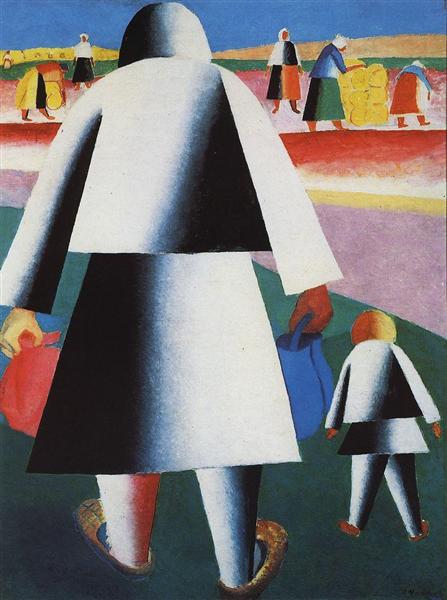Description
In the vastness of the avant -garde of the twentieth century, Kazimir Malevich stands as a seminal figure whose contributions to art cannot be underestimated. His work "Marpha and Van'ka - 1929" is presented as an introspective window towards a peculiar stage of his career, where he mixes elements of suprematism with returns to figuration.
Malevich, known for being the pioneer of suprematism a movement that stood in the purest abstraction, with floating geometric shapes in a non -objectual space offers us in "Marpha and Van'ka" a visual testimony of its late phase, characterized for a return to the representation of the human being, although not exempt from its unique visual language.
The composition of "Marpha and Van'ka" is a conjunction of figures that are located in a spatial synthesis wrapped by the family use of Malevich of the colors and geometric shapes. In the center of the work, two human figures face us with faces that lack the usual details, reminding us of the formal deconstruction promoted by the artist. These figures are trapped in a perpendicularity that suggests both stability and inherent tension. The silhouettes, simple and robust, acquire an amplified presence due to the attention that Malevich provides to the compositional structure.
The color in this work has a vibrant simplicity. Malevich displays a palette where white, black, and several shades of red and blue predominate. These chromatic, although basic options evoke an emotional and conceptual depth that invites you to explore beyond the obvious. The figures, which we could deduce are Marpha and Van'ka, are delineated in a contrast that highlights each form against the background, reminiscent of the fertile terrain of the suprematist space, with a certain enigma and abstraction that is complemented by the figuration.
The bodies are deliberately flattened, subject to geometrization that is characteristic of Malevich's work. However, there is a warmth in the interaction between the two figures, a possible insinuation of an interpersonal relationship enclosed within that minimalist and rigorously structured pictorial space.
Malevich, during the last years of his life, in which this painting was created, began to reintroduce the human figure, in what some analysts interpret as an answer to the growing ideological and political pressures of the Soviet Russia. This phase marks a reconciliation between the purity of its abstract stage and the historical need to communicate through recognizable ways. "Marpha and Van'ka - 1929" thus becomes an artistic crossroads where Malevich's mind connects suprematism and representation, creating a space where both can coexist.
The work serves to remind art fans of Malevich's ability to transform the everyday into something subversive and deeply intellectual. With "Marpha and Van'ka - 1929", we are witnessing a quiet but powerful meditation on the human figure and the form, which remains relevant and resonant in contemporary discourse on art and history.
KUADROS ©, a famous paint on your wall.
Hand-made oil painting reproductions, with the quality of professional artists and the distinctive seal of KUADROS ©.
Art reproduction service with satisfaction guarantee. If you are not completely satisfied with the replica of your painting, we refund your money 100%.

